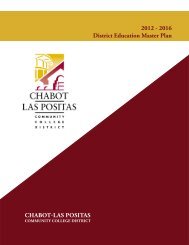City College of San Francisco - California Competes
City College of San Francisco - California Competes
City College of San Francisco - California Competes
Create successful ePaper yourself
Turn your PDF publications into a flip-book with our unique Google optimized e-Paper software.
STANDARD II.A<br />
program develops a self-study report that assesses<br />
its level <strong>of</strong> learning and teaching excellence,<br />
establishes a six-year plan, and identifies, where<br />
appropriate, new costs for achieving planning<br />
objectives. Fundamentally, the self-study report<br />
provides programs an opportunity to self-reflect,<br />
discover strengths and weaknesses, and identify<br />
areas in need <strong>of</strong> improvement.<br />
The DACUM 3 process has also been utilized to<br />
ensure instructional programs are current and <strong>of</strong><br />
high quality. Essentially, DACUM is a refined<br />
brainstorming process where a facilitator works<br />
closely with members <strong>of</strong> a program’s advisory<br />
committee to design new programs or revise<br />
existing programs.<br />
Many vocational programs (e.g., Registered<br />
Nursing, Diagnostic Medical Imaging, and<br />
Licensed Vocational Nursing) are subject to additional<br />
review by external agencies. These reviews<br />
are primarily for program accreditation purposes<br />
and include a review process similar to the institution’s<br />
Program Review (e.g., an assessment <strong>of</strong><br />
program currency is made). [Ref. 1]<br />
The institution uses a variety <strong>of</strong> means to decide<br />
the fields <strong>of</strong> study in which to <strong>of</strong>fer programs.<br />
Market trends and industry needs play a significant<br />
role in the development <strong>of</strong> new programs.<br />
For example, the institution recently received a<br />
$4.2 million grant from the Gordon and Betty<br />
Moore Foundation. This grant represents a<br />
unique public-private collaboration between the<br />
institution and the <strong>California</strong> Pacific Medical<br />
Center and St. Luke’s Hospital. This collaboration<br />
will significantly increase the number <strong>of</strong><br />
students admitted into the Nursing Program by<br />
augmenting the current program with afternoon<br />
and evening classes that are flexible in delivery<br />
and promote a learning environment that is<br />
competency-based and emphasizes problem<br />
solving.<br />
On other occasions, the institution has partnered<br />
with community-based organizations in<br />
order to address labor shortages. The Mission<br />
Hiring Hall, for example, asked that a program<br />
be developed to train secretaries for the construction<br />
industry. The Hiring Hall recruits<br />
prospective students, secures student stipends<br />
and places these students into internships. The<br />
Hiring Hall also provides counselors in order to<br />
ensure the greatest likelihood <strong>of</strong> student success.<br />
These partnerships are examples <strong>of</strong> how the<br />
institution develops instructional programs that<br />
reflect the work needs <strong>of</strong> the community and<br />
serve the training needs <strong>of</strong> students.<br />
II.A.1.a. The institution identifies and seeks to<br />
meet the varied educational needs <strong>of</strong> its students<br />
through programs consistent with their educational<br />
preparation and the diversity,<br />
demographics and economy <strong>of</strong> its communities.<br />
The institution relies upon research and analysis<br />
to identify student learning needs and to assess<br />
progress toward achieving stated learning outcomes.<br />
The institution serves a great diversity <strong>of</strong> students<br />
in a wide variety <strong>of</strong> programs in credit,<br />
noncredit, contract education, and continuing<br />
education that are designed to meet the varied<br />
needs <strong>of</strong> our students. Information on student<br />
demographics is readily available from reports<br />
such as the Environmental Scan Report produced<br />
by the Office <strong>of</strong> Research, Planning and Grants<br />
and the Decision Support System (DSS) 4 that is<br />
maintained by the same <strong>of</strong>fice. [Ref. 22] It is<br />
important to note that a large number <strong>of</strong> basic<br />
skills students are served in the credit program.<br />
3 DACUM is an acronym that stands for Designing ACurriculUM. The DACUM process has been used for over 40 years to<br />
conduct job analyses in every field imaginable all over the world. It is primarily used to create and update training and education<br />
programs. It is unique in the sense that expert workers are used to determine curriculum, rather than having curriculum<br />
selected by instructors, college pr<strong>of</strong>essors, or training managers. By making workers the experts, DACUM narrows the gap<br />
between what is typically taught in classes and what workers actually need to know to achieve excellence in the workplace.<br />
4 The Decision Support System (DSS) was developed by the Office <strong>of</strong> Research, Planning and Grants in order to enhance access<br />
to institutional data pertaining to students, courses and programs. Available to the <strong>College</strong> community in 2001, the DSS is a<br />
web-based interface within the institution’s intranet that accesses a data warehouse. The DSS was shown to have a positive<br />
impact on user perceptions <strong>of</strong> data and the use <strong>of</strong> data in decision making (Decentralizing Data Through Decision Support<br />
Systems: The Impact <strong>of</strong> Increased Access to Data on Decision-Making).<br />
110 CITY COLLEGE OF SAN FRANCISCO







